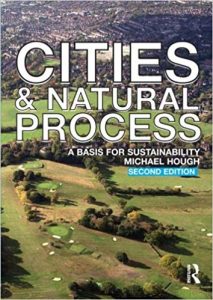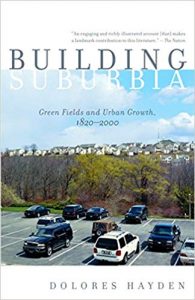Students often ask me what planning books they should be reading, especially when they are beginning their graduate studies in planning at York (and curiously, when they are about to finish).
Incoming students are typically interested in issues related to the natural environment and planning, social justice and planning (especially affordable housing), and sustainable alternatives to suburban planning and design (retrofitting, “smart growth”, new urbanism, transit-oriented development (TOD) and more).
Many students often ask for my suggestions during the summer months, which makes me think that there is more room for books that are less “textbooks” and—okay maybe not quite a “beach read”—but at least a pleasure to read. So the list is below to get you started.
I’ve not included favourite articles from scholarly journals, as these are typically not easily available without having access to the library system.
As a Canadian planner and geography scholar, I dearly would like to only suggest Canadian books to incoming students. But so much of the writing on planning theory comes from either the United States or Britain, as you’ll see from the list. If you’ve travelled, you’ll know southern Ontario seems similar in many ways to the US and UK, especially in terms of shared popular culture and similar road and settlement layouts.
But the US persists in having so much of governance at the local level, without strong regional government the way we are used to in Ontario (where the province has the responsibility for land-use planning, which is downloaded to municipalities). So what? Much of the US writing is about trying to cope with wicked problems, like watersheds and mobility, which ignore political boundaries, where much of the “integrated” work is more possible in Ontario because of the province’s involvement. The UK has even more centralised oversight over planning policy but seemingly a lot of latitude locally over development approvals within that). The UK also deals more with the European context of urban vs rural tensions in planning (still pre-Brexit).
 For students interested in environment and planning, I would suggest reading Michael Hough’s Cities and Natural Process (1995) I keep assigning it in class even though it is becoming quite dated because students seem to get a lot from it. He captures the sense of working with the landscape that has so influenced my interest in landscape and planning (he was one of my FES major paper supervisors).
For students interested in environment and planning, I would suggest reading Michael Hough’s Cities and Natural Process (1995) I keep assigning it in class even though it is becoming quite dated because students seem to get a lot from it. He captures the sense of working with the landscape that has so influenced my interest in landscape and planning (he was one of my FES major paper supervisors).
Anne Whiston Spirn’s The Granite Garden (1984) is a readable introduction to thinking about the choices we make when shaping the natural landscape in cities. She is a prolific writer and has an interesting website, which is worth the visit: annewhistonspirn.com.
 I thoroughly enjoy reading Witold Rybczynski’s A Clearing in the Distance (2000) about the life and work of Frederick Law Olmsted, one of the first landscape architects. The book is a good read, especially the bit about the making of Central Park in Manhattan.
I thoroughly enjoy reading Witold Rybczynski’s A Clearing in the Distance (2000) about the life and work of Frederick Law Olmsted, one of the first landscape architects. The book is a good read, especially the bit about the making of Central Park in Manhattan.
On social justice, I would suggest starting with a couple of geography books: City of Quartz (1998) by Mike Davis and Social Justice and the City by David Harvey (Revised 2009). Davis’s book is about Los Angeles and the chasm between the lived environments of rich and poor people and the role planners (and many others) have played in inscribing inequity in the region’s landscape. Harvey’s book, especially, I think, Chapter 3 on territorial distributive justice, can be eye-opening in thinking through the stark divisions between income and race in US cities.
I also very much like the introduction to Incomplete Streets (2014) edited by Stephen Zevestoski and Julian Agyeman. I suggest it to students interested in transportation planning and those who are interested in the concept of “complete streets” as a way to try to balance accommodating the cars in our cities with the needs of, well, everything else. This book provides a critique of complete streets, only because design can’t fix everything that’s wrong with urban life—the problem is more complex, of course.
And the suburbs: every new student loves to hate the suburbs. So, for the suburban critique and its alternatives:
Jane Jacobs, The Death and Life of Great American Cities: published in 1961, it is still referred to often in just about everything. I like the book. She had good ideas. Jacobs became a Canadian (left the States with her sons during the Vietnam war). She is famous for her ideas about “eyes on the street” and reusing old buildings. And she was a harsh critic of the Modern architecture and the Modern flat-earth planning approach of the time. Yes, many of her ideas are worthy of thinking about today but surely, more than 50 years later, we can suggest people read something else? But yes, you should probably read it (and I mean really read it; I suspect many who use Jacobs so glowingly in their tweets have not).
Kevin Lynch is scholar from the same era as Jacob’s writing and I find his ideas to be very compelling. He is known for his book, Image of the City (1960) where he explored the idea of using mental maps to understand how people think about and navigate their city. His book Good City Form (1984) is an easy-to-read journey through ideas around urban settlement forms and planning history. My favourite because of my interest in the way we shape our landscapes and then how they shape our own lives is What Time is this Place? (1972). Of course, these books seem out-of-date today in the sense that he was an east coast white male professor working at MIT and writing before we had the discussions about profound inequality of race, gender and income in accessing and belonging to city spaces. Nonetheless, today I find his ideas and approaches to be potentially emancipatory if taken up and used by planners to think empathetically about how others use space, and then to make the city more legible and accessible.
 Dolores Hayden, Building Suburbia (2009) is a great introduction to the making of North American suburbs. I especially like Hayden’s focus on landscape and settlement patterns created by the myriad of choices people make about their everyday lives.
Dolores Hayden, Building Suburbia (2009) is a great introduction to the making of North American suburbs. I especially like Hayden’s focus on landscape and settlement patterns created by the myriad of choices people make about their everyday lives.
Peter Hall’s Cities of Tomorrow (originally published in 1988 but now in its Fourth Edition, 2014; Sir Peter Hall has since passed away, so this will be the last one edited by him): still a classic and still represents the narrative planners learn about the eras of city building and change and the issues around them. The book isn’t without its problems: the focus is very much about British and American male perspectives of history and change but the sense of the eras that cities have gone through is worth the (mostly) engaging read.
And, because I can’t help but suggest a couple of textbooks:
I recommend Planning Canadian Communities by Gerald Hodge & David Gordon (6th edition; 2013). The only text that describes how Canadian planning is carried out, and some historical context of how we got where we are.
Canadian Cities in Transition is a series of textbooks produced by faculty at the University of Waterloo. A great introduction to contemporary topics having to do with Canadian cities. Each edition is different, however, so it’s worthwhile to look through the tables of contents for chapters related to your areas and places of interest. The 6th edition was published in 2015.
Above all, read the landscape around you and think about what your city (suburb, exurb, countryside) means to you! What do you want to know more about?
